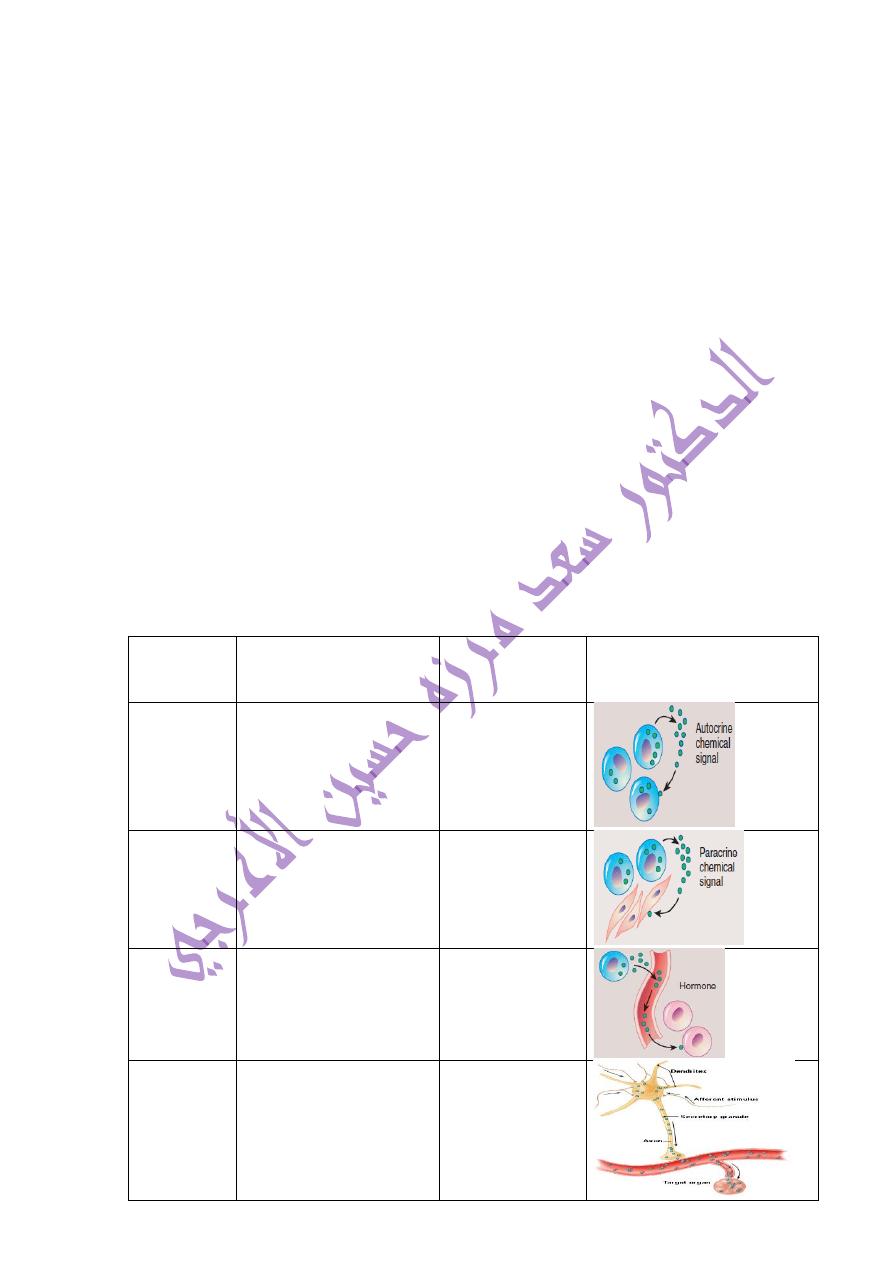
Medical
Endocrinology 1 Prof. Dr. Saad Merzah Hussein Alaraji
University Of Babylon, College Of Medicine, Dep. Of Medical Physiology
1
Medical Endocrinology
قد يكون
الإنسان
قبطان اجله لكنه
يكون
أيضا
فريسة سكر دمه
Wilfred Oakley
, إفرازات الغدة الكظرية, مدلا ركس ةدايز , سفنتلا قمع , ضبنلا ةدايز ودبت دق
أشياء غير
مترابطة . وفي ذات ليلة أرقتها توجهت في ذهني فكره تقول بأن كل هذه
التغيرات يمكن آن تفهم على إنها جهود يبذلها الجسم لغرض الف
ر والك ر
Walter, B. Cannon
The nervous and endocrine systems are the two major regulatory systems of
the body, and together they regulate and coordinate the activity of essentially all
other body structures. The nervous system functions something like telephone
messages sent along telephone wires to their destination. It transmits information
in the form of action potentials along the axons of nerve cells. Chemical signals in
the form of neurotransmitters are released at synapses between neurons and the
cells they control. The endocrine system is more like radio signals broadcast
widely that everyone with radios tuned to the proper channel can receive. It sends
information to the cells it controls in the form of chemical signals released from
endocrine glands. The chemical signals are carried to all parts of the body by the
circulatory system. Cells that are able to recognize the chemical signals respond
to them and other cells do not.
The term endocrine is derived from the Greek words endo, meaning within,
and crino, to separate. The term implies that cells of endocrine glands secrete
chemical signals that influence tissues that are separated from the endocrine
glands by some distance.
The endocrine system is composed of glands that secrete chemical signals
into the circulatory system . In contrast,exocrine glands have ducts that carry their
secretions to surfaces.
1. Hormones are chemical substances, involved in cell-to-cell communication,
that promote the maintenance of homeostasis.
2. There are six classes of steroid hormones, based on their primary actions.
3. Most polypeptide hormones are initially synthesized as preprohormones.
4. Steroid hormones and thyroid hormones are generally transported in the
bloodstream bound to carrier proteins, whereas most peptide and protein
hormones are soluble in the plasma and are carried free in solution.
5. RIA and ELISA have provided major advancements in the field of endocrinology,
but each type of assay has limitations.
6. Altered hormone-receptor interactions may lead to endocrine abnormalities.

Medical
Endocrinology 1 Prof. Dr. Saad Merzah Hussein Alaraji
University Of Babylon, College Of Medicine, Dep. Of Medical Physiology
2
The location of major endocrine glands in the human body.
The secretory products of endocrine glands are called hormones , a term
derived from the Greek word hormon, meaning to set into motion.
Traditionally, a hormone is defined as a chemical signal, or ligand, that
(1) Is produced in minute amounts by a collection of cells;
(2) Is secreted into the interstitial spaces;
(3) Enters the circulatory system, where it is transported some distance;
(4) Acts on specific tissues called target tissues at another site in the body to
influence the activity of those tissues in a specific fashion.
Although the stated differences between the endocrine and nervous systems
are generally true, exceptions exist. For example, some endocrine responses are
more rapid than some neural responses, and some endocrine responses have a
shorter duration than some neural responses.
Some neurons secrete chemical signals called neurohormones into the
circulatory system, which function like hormones. Also, some neurons directly
innervate endocrine glands and influence their secretory activity.
Neurons release chemical signals at synapses in the form of
neurotransmitters and neuromodulators, and the membrane potentials of some
endocrine glands undergo depolarization or hyperpolarization, which results in
either an increase or a decrease in the rate of hormone secretion. Conversely,
some hormones secreted by endocrine glands affect the nervous system and
markedly influence its activity.
Intercellular chemical signals
Intercellular chemical signals allow one cell to communicate with other cells.
These signals coordinate and regulate the activities of most cells.

Medical
Endocrinology 1 Prof. Dr. Saad Merzah Hussein Alaraji
University Of Babylon, College Of Medicine, Dep. Of Medical Physiology
3
Neurotransmitters and neuromodulators are intercellular chemical signals that play
important roles in the function of the nervous system .
Hormones are intercellular chemical signals secreted by endocrine glands.
Autocrine chemical signals are released by cells and have a local effect on
the same cell type from which the chemical signals are released. Examples include
prostaglandin like chemicals released from smooth muscle cells and platelets in
response to inflammation. These chemicals cause the relaxation of blood vessel
smooth muscle cells and the aggregation of platelets. As a result, the blood
vessels dilate and blood clots.
Paracrine chemical signals are released by cells and affect other cell types
locally without being transported in the blood. For example, a peptide called
somatostatin is released by cells in the pancreas and functions locally to inhibit the
secretion of insulin from other cells of the pancreas .
Pheromones are chemical signals secreted into the environment that modify
the behavior and the physiology of other individuals. For example, pheromones
released in the urine of cats and dogs at certain times are olfactory signals that
indicate fertility. Evidence supports the existence of pheromones produced by
women that influence the length of menstrual cycles in other women.
Functional Classification of Intercellular Chemical Signals
Intercellular
Chemical
Signal
Description
Example
Autocrine
Secreted by cells in a local
area and influences the
activity of the same cell
type from which it was
secreted
Prostaglandins
Paracrine
Produced by a wide variety
of tissues and secreted into
tissue spaces; usually has
a localized effect on other
tissues
Histamine
,
prostaglandins
Hormone
Secreted into the blood by
specialized cells; travels
some distance to target
tissues; influences specific
activities
Thyroxine, insulin
Neurohormo
ne
Produced by neurons and
functions like hormones
Oxytocin,
antidiuretic
hormone

Medical
Endocrinology 1 Prof. Dr. Saad Merzah Hussein Alaraji
University Of Babylon, College Of Medicine, Dep. Of Medical Physiology
4
Neurotrans
mitter
or
neuromodul
ator
Produced by neurons and
secreted into extracellular
spaces by presynaptic nerve
terminals; travels short
distances; influences
postsynaptic cells
Acetylcholine,
epinephrine
Pheromone
Secreted into the
environment; modifies
physiology and behavior
of other individuals
Sex pheromones
are released by
humans and many
other animals.
They are released
in the urine & other
external
secretions.Pheromo
nes produced by
women influence
the length of the
menstrual cycle of
other women.
A hormone is a chemical messenger released by an endocrine gland into the
circulation. Once released, a hormone travels in the bloodstream and affects only
cells in the body that have receptors (binding sites) specific to it. Cells that respond
to a particular hormone are called target cells for that hormone. Typically, a
hormone is released in bursts from an endocrine gland in a pattern that often
follows an inherent daily (diurnal) rhythm. The burst of hormone release can be
increased or decreased above or below baseline level by various inputs to the
gland. Inputs that affect hormone release involve:
(1) Stimulation by another hormone or neurotransmitter, or
(2) Stimulation caused by a decrease or increase in a certain ion or nutrient.
Examples of hormones that cause an increase or decrease in another
hormone's release include all the hypothalamic hormones affecting the anterior
pituitary.
Examples of neurotransmitters affecting a hormone's release include the
release of insulin in response to epinephrine and norepinephrine stimulation. Ions
that influence the release of a hormone include calcium ion's effect on parathyroid
hormone, and sodium ion's effect on aldosterone.
Nutrients that affect the release of hormones include the amino acids that
stimulate the release of insulin and growth hormone. Frequently, one endocrine
gland is stimulated simultaneously by several different inputs.
Thank You
Prof. Dr. Sa'ad Merza Alaraji
